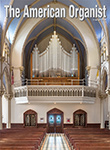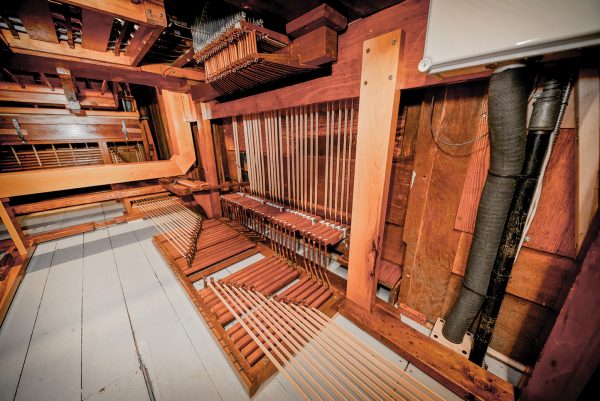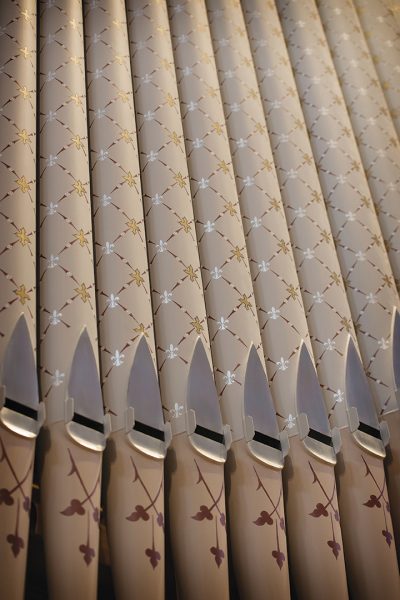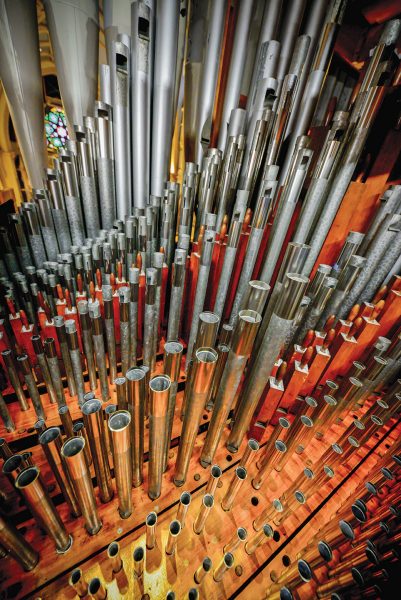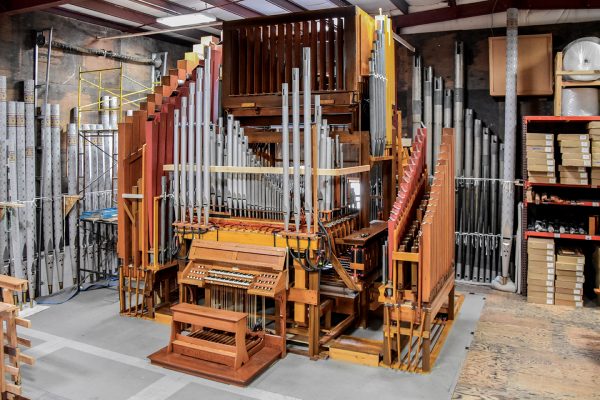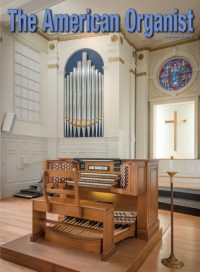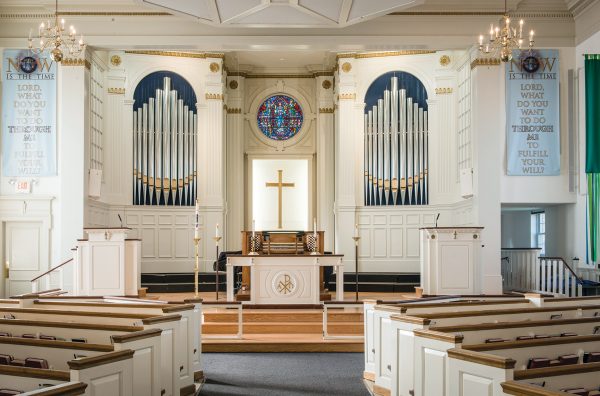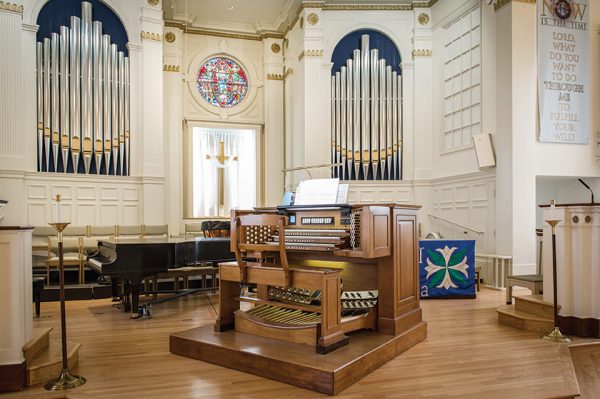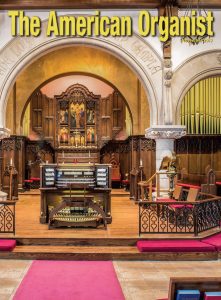 The Episcopal Church of SS. Andrew and Matthew
The Episcopal Church of SS. Andrew and Matthew
Wilmington, Delaware
Quimby Pipe Organs Inc. • Warrensburg, Missouri
by T. Daniel Hancock
Cover photo credit: Danny Schweers
View the Stop List
View an enlarged cover
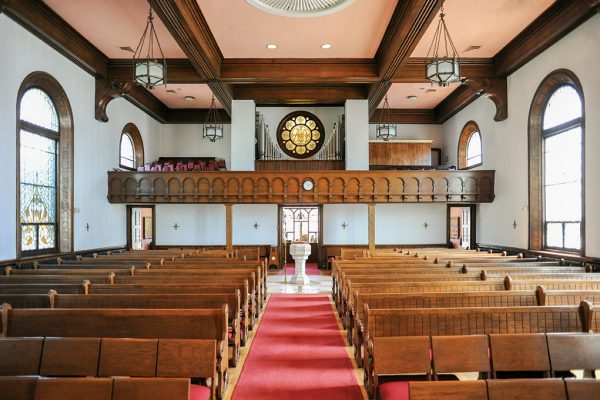
The Episcopal Church of Saints Andrew and Matthew (SsAM) is a vibrant faith community located on the southwestern edge of downtown Wilmington, Delaware, where the center city district gives way to the historic Quaker Hill neighborhood. Founded in 1996, SsAM is the result of a carefully considered and executed combination of two Episcopal parishes: St. Andrew’s Church, founded 1829, and St. Matthew’s Church, founded 1846. St. Andrew’s was primarily a white congregation, while St. Matthew’s was predominately black; both parishes were rich in formational historical ties to Wilmington and the Diocese of Delaware.
In the new venture, constituents of both parishes emphatically avoided the use of the word “merger” and all of the negative connotations and imagery that can accompany it. Rather, the vision for the parish was one of a multifaceted but united identity; one that fully recognized the unique heritage of each parish while also uniting the new community in “Christian fellowship, racial diversity, and advocacy for justice.” The results are evident to any visitor: an eclectic, honest parish with real compassion and heart; actively engaged in the community.
Almost from the beginning, the idea of a new pipe organ—one that would be a symbol of the new parish—was considered, and groundwork laid for this reality. Although the new parish inhabits the former St. Andrew’s facility, ranks of pipes were removed from the St. Matthew organ, a 1955 Möller, with the idea that perhaps pipes from both church organs could someday be utilized in the creation of a new instrument.
The St. Andrew organ, a 1945 Möller, had five 16′ stops in the Pedal, ingeniously engineered for concise placement within a comparatively small organ chamber. The Möller retained several ranks from the previous organ, a 1906 C.S. Haskell, which in turn most likely possessed mid-to-late 19th-century pipework from a previous organ. In 1957, a seven-rank Gallery division was added.
In 2012, the Episcopal Cathedral of St. John in Wilmington was closed, and many of the cathedral parishioners made their way to SsAM, further contributing to the diversity of the parish fabric. Accordingly, plans were made to include pipes from the cathedral organ, a 1920 Möller, in the new organ.
Thus, the music program at the church is wide-ranging, and the choir, under the leadership of organist and choirmaster David Christopher, can turn on a dime from Palestrina to spirituals, or from Howells to gospel music in a convincing fashion.
The new organ, our Opus 72, is just as flexible, and serves as an up-front, tangible symbol of the successful creation of one new entity from many disparate parts. It is a 46-rank instrument with three completely enclosed manual divisions in the chancel, and an unenclosed Antiphonal division in the location of the former Möller gallery division.
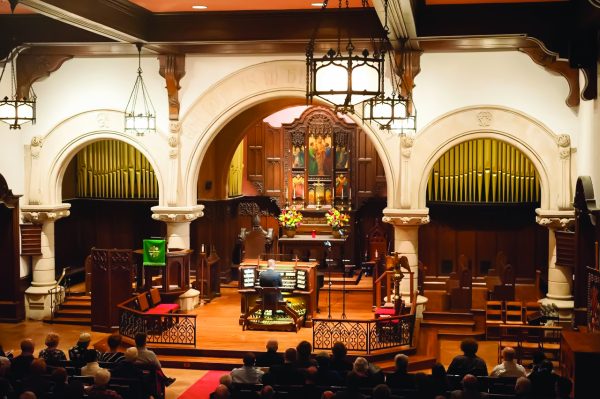
A new chamber was constructed to house the Choir division, opposite the existing organ chamber, where it is fronted on two sides (altar and nave) with new nonspeaking pipe facades that are mirror duplicates of the 1906 C.S. Haskell facade fronting the Great and Swell. Although the early 20th-century facade is dominating, with pipes of considerable overlength, its appearance is tempered by the presence of a beautifully carved stone arcade with three low-sprung arches in front of the altar and choir loft, visually and acoustically bisecting the nave from the organ chambers and choir.While visually arresting, this stone arcade creates an acoustical obstacle course behind which is a relatively high plaster ceiling. For the choir, it serves a kind of mixing chamber that aids in creating ensemble and blend; for the organ, it works as a tone trap, especially for the Great division, which is located high in the chamber, over the Swell and Pedal.
We developed a solution that meets this challenge both with generous scaling and characteristic, harmonically rich voicing, both of which give the instrument a sense of presence and colorful vitality which are almost overwhelming in the choir loft, but ultimately supportive and present in the nave for congregational song. Because all the chancel divisions are completely enclosed and separately expressive, this also allows for effective choral accompaniment.
The existing pipework was generously scaled and of excellent construction, especially the 16′ stops, all of which were included for reuse in the new organ, and which remain enclosed together with the manual divisions; many of the unit Pedal windchests from the 1945 Möller were restored for reuse because of the ingenious, compact layout. New electropneumatic slider windchests in the Quimby-Blackinton style were constructed for the manual divisions, with new electropneumatic windchests for reeds and extended stops. Our slider windchests allow remarkable efficiency for placement of pipework, and this has further enabled the rank count in the Great and Swell to exceed what it previously was.
The tonal characteristics of Opus 72 are idiomatic of QPO work in recent decades: heroically scaled diapason choruses, inspired by the work of 19th-century British organbuilder T.C. Lewis, voiced so that each stop is harmonically rich and colorful, which also enables individual voices to blend and meld together in ensemble. These are matched or exceeded by chorus reeds that are at once brilliant and foundational. If the reeds dominate the full ensemble, it’s not because the flues are weak; rather, the voicing and timbre of reeds constructed and voiced by QPO enables them both to stand on their own in chorus, and to effectively lock together with the flues in an exciting and powerful manner.
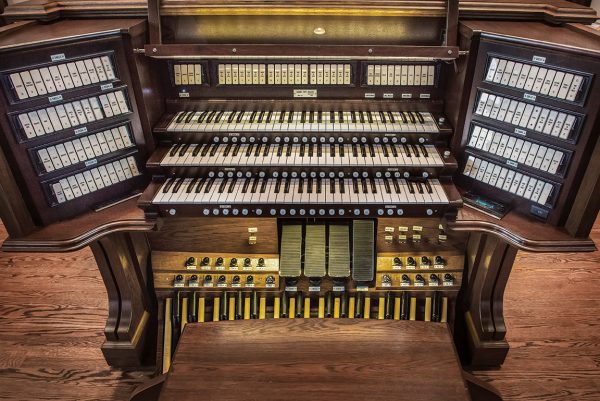
The Swell reed chorus includes an 8′ Trumpet and 4′ Clarion along French Romantic lines, with adaptations made in construction and voicing for success in American acoustics: here, brilliance and fire are combined with a foundational quality well suited to a less reverberant acoustic. By contrast, the Great Trumpet is inspired by English Romantic work, but is in no way iron-clad or tromba-esque.
The flue and reed chorus-work is contrasted by a variety of strings, flutes, and lyrical reeds that provide characteristic color voices for use in a wider range of solo and ensemble possibilities. There is considerable diversity in unison flues and reeds that are colorful, individually articulate, effective for smaller finely graded ensembles, and yet capable of creating a flood of foundation tone.
The Antiphonal is unenclosed in the gallery tower alcove; it frames a rose window at the rear of the church. It lends additional foundational presence in the nave for congregational singing, and colorful voices provide opportunities for antiphonal effects. This division contains the 8′ Harmonic Trumpet, a powerful reed with a commanding solo voice that can be heard over the full organ ensemble and exhibits a mix of fire and restraint; its forceful presence is not in the least offensive or startling, as so many loud solo reeds are.
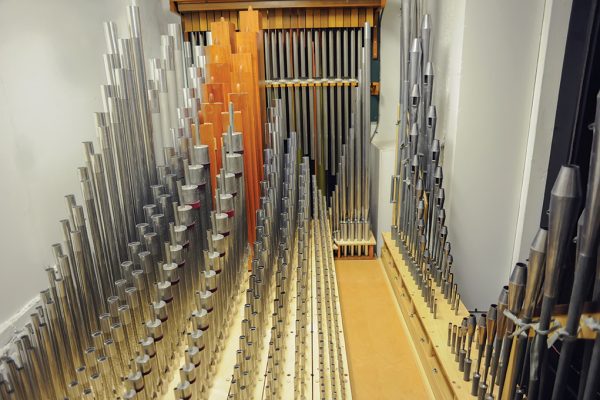
The new three-manual and pedal console is constructed of paneled oak, finished to match church wainscoting, with a dark-finished walnut interior. The design of the console, with rocking stop tablets on angled jambs, is modeled on a particularly compact and elegant three-manual console built by the Aeolian Organ Company in 1930 for Memorial Presbyterian Church in St. Louis, Missouri. This was selected because it allowed for maximum flexibility for placement at several locations on the chancel platform, and it is so attractive, we hope that it will serve as a prototype for future QPO instruments, alongside our standard drawknob console design.
Just as the completed instrument is a symbol for the interwoven yet cohesive fabric of the SsAM parish community, so was the campaign to fund the work. The organ campaign was linked to one raising capital for the renovation of the parish kitchen. In the end, 400 donors from the parish and the larger community made individual donations of $5 to over $200,000. Credit for this is due in large part to the unflappable persistence and leadership of Patricia Saunders, campaign chair. The result, in an age when organ projects are more often than not largely funded by one or a few individuals, is an instrument that is already well beloved by parish and community, and bestowed with a widely shared sense of pride and ownership.
The organ was dedicated on February 19, 2017, with an inaugural recital played by Ken Cowan on February 25.
T. Daniel Hancock, AIA, is president of Quimby Pipe Organs Inc.
